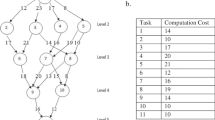Abstract
In this paper, the performance evaluation of distributed and many-core computer complexes, in conjunction with their consumed energy, is investigated. The distributed execution of a specific problem on an interconnected processors platform requires a larger amount of energy compared to the sequential execution. The primary reason is the inability to fully parallelize a problem due to the unavoidable serial parts and the intercommunication of utilized processors. Distributed and many-core platforms are evaluated for the power their processors demand at the idle and fully utilized state. In proportion to the parallelized percentage each time, the estimations of the theoretical model were compared to the experimental results achieved on the basis of the performance/power and performance/energy ratio metrics. Analytical formulas for evaluating the experimental energy consumption have been developed for both platforms, while the experimental vehicle was a widely known algorithm with different parallelization percentages.




Similar content being viewed by others
References
Amdahl G (1967) Validity of the single-processor approach to achieving large scale computing capabilities. In: Proceedings of the AFIPS conference
Mudge T (2001) Power: a first-class architectural design constraint. Computer 52–58
Benner RE, Gustafson JL, Montry GR (1988) Development and analysis of scientific application programs on a 1024-processor hypercube. In: SAND 88–0317, Sandia National Laboratories
Shi Y (1996) Reevaluating Amdahl’s law and Gustafson’s law. Computer and Information Sciences Department, Temple University
Woo DH, Lee HHS (2008) Extending Amdahl’s law for Energy-efficient computing in the many-core era. IEEE Comput 41(12):24–31
Gustafson JL (1988) Reevaluating Amdahl’s law. CACM 31(5):532–533
Gonzalez R, Horowitz M (1996) Energy dissipation in general-purpose microprocessors. IEEE J Solid State Circuits 31(9):1277–1284
Lu J, Guo Y (2011) Energy-aware fixed-priority multi-core scheduling for real-time systems. In: Proceedings of the RTCSA-IEEE 17th international conference, vol 1, pp 277–281
Yang L, Lin M, Yang T (2012) Multi-core fixed priority DVS scheduling. In: Algorithms and architectures for parallel processing, Lecture Notes in Computer Science, vol 7439, pp 517–530
High-Performance Portable MPI (MPICH) Last visit: Apr 2014. http://www.mpich.org
AMD Server Processors Last visit: Apr 2014. http://www.amd.com/en-us/products/server
Londono SM, Gyvez JP (2010) Extending Amdahl’s law for energy efficiency. In: Proceedings of the ICEAC conference, pp 1–4
Marowka A (2012) Extending Amdahl’s law for heterogeneous computing. In: Proceedings of the IEEE ISPA conference, pp 309–316
Cassidy AS, Andreou AG (2012) Beyond Amdahl’s law: an objective function that links multiprocessor performance gains to delay and energy. IEEE Trans Comput 61(8):1110–1126
Author information
Authors and Affiliations
Corresponding author
Rights and permissions
About this article
Cite this article
Karanikolaou, E.M., Milovanović, E.I., Milovanović, I.Ž. et al. Performance scalability and energy consumption on distributed and many-core platforms. J Supercomput 70, 349–364 (2014). https://doi.org/10.1007/s11227-014-1248-0
Published:
Issue Date:
DOI: https://doi.org/10.1007/s11227-014-1248-0




